A unique variety with a rich harvest and excellent taste - "Ivanhoe" pepper: description and tips for growing
Pepper is native to Central and South America. It does not tolerate temperature changes and requires a lot of light. After the invention of the seedling method, it became possible to grow it in the conditions of our country. Now it is a favorite culture of many gardeners. Pepper contains many useful substances; it is used to prepare dishes that have been loved since childhood.
Fruits with a rich aroma and sweet pulp are most appreciated. The Ivanhoe variety meets these requirements. It is susceptible to temperature extremes, but resistant to typical diseases of the Solanaceae family. How to grow this culture on your site - read on.
The content of the article
What kind of pepper is this
Ivanhoe is included in the Russian state register and recommended for cultivation in southern regions.
Since Ivanhoe is a varietal pepper, the seeds harvested from its harvest are used for planting... Planting material is taken from fruits that have ripened on the bush. The seeds are cleaned, dried and stored in fabric bags.
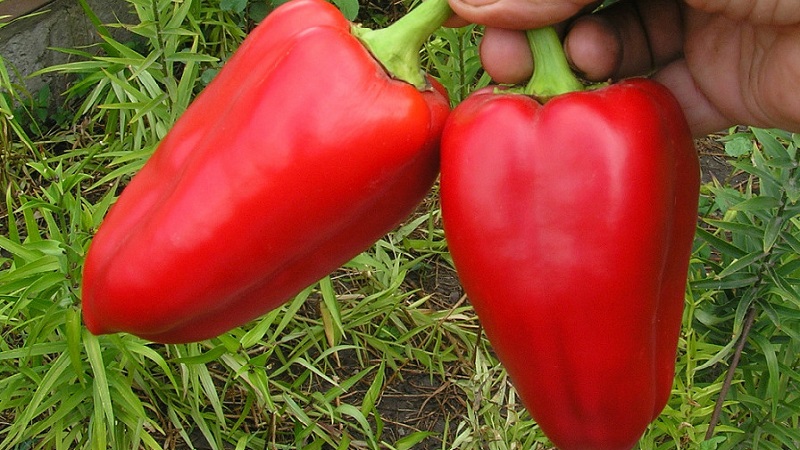
Distinctive features
The main distinguishing feature of Ivanhoe is its fruits. Pepper has a bright red color and a glossy shell... Its flesh is thick and juicy. The fruits are large.
The taste of pepper is rich, sweet, with a slight sourness... Strong peppery aroma. An unripe crop has no bitterness.
Pepper is versatile thanks to its thick flesh in use. It is consumed fresh and canned. It is suitable for hot dishes and lecho.
Advice! Thick-walled Ivanhoe is frozen whole. To do this, it is cleaned of seeds, folded into a large bag and placed in the freezer. It is convenient to use such blanks for stuffing in winter.
Another feature of pepper is its short stature.... He does not need a garter and pinch.
The variety is resistant to most diseasescharacteristic of nightshade crops. This reduces the need for chemical treatment.
Negative feature of Ivanhoe - the variety does not tolerate cold snaps. In all regions except the southern ones, it is grown in a greenhouse.
Main characteristics of the variety
Pepper Ivanhoe has impressive yields... Gardeners are pleased with its other properties.
Description and characteristics of the variety:
| Parameter | Indicators |
| Bush type | Determinant. Half-stamped. Reaches 45-65 cm in height. The bushes are powerful. The crown is branched. The amount of foliage is average. The leaves are dark green, medium-sized, simple. The inflorescences are simple. |
| Growing method | Poorly tolerates a cold snap. In the south, it is grown outdoors, in other regions, in greenhouses. |
| Yield | High. From 1 sq. m collect up to 9 kg. |
| Fruit | Large. The weight of each of them varies within 150-250 g. The color at the stage of biological maturity is bright red, the fruits are glossy. Unripe peppers have a white-yellow hue. The shape is elongated, ribbed over the entire area. The pulp is thick (7 cm). |
| Transportability | High. Fruits do not crumple when transported over long distances. Stored in the refrigerator for more than 3 weeks. |
| Ripening terms | Early ripe. The first fruits turn red 100-110 days after sowing the seeds. |
| Disease resistance | Possesses high resistance to diseases of nightshade crops. |
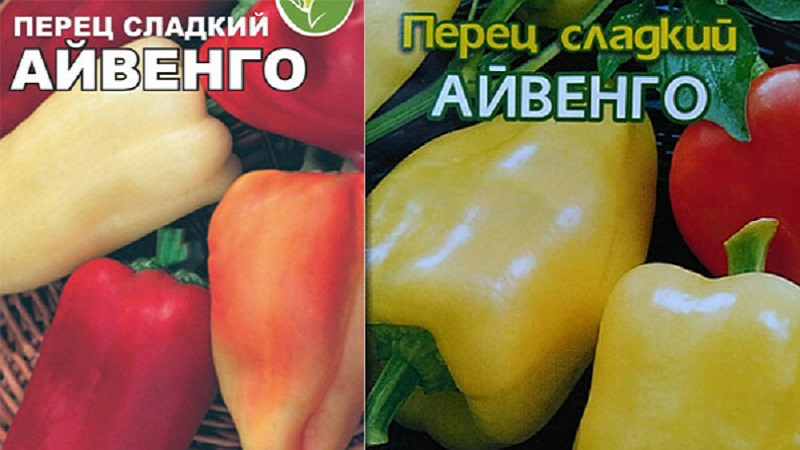
Preparation for growing
The planting material of the pepper must be prepared for use.... This will increase its resistance to adverse environmental factors and accelerate seed germination.
The seeds are sorted out, leaving only light, whole seeds... They are soaked in warm water for half an hour. Instances that float are considered tainted, they will not germinate. Use planting material that has sunk to the bottom.
Then the seeds are treated with a disinfecting solution. Them soaked in one of the products:
- light pink solution of potassium permanganate - 15 min;
- hydrogen peroxide - 15 minutes;
- phytosporin - 1 hour;
- aloe juice - 12 hours;
- soda solution (1 tsp for 1 tbsp. of water) - 12 tsp.
 Then stimulate seed growth... This is done in one of the following ways:
Then stimulate seed growth... This is done in one of the following ways:
- Several layers of paper are placed at the bottom of a deep container. It is poured over with warm water. Seeds are stacked on top. They are covered with several more layers of wet paper. In this form, the planting material is left until it germinates. During this time, the paper is moistened as it dries.
- The seeds are immersed for 24 hours in a cloth soaked in a growth stimulant.
- The planting material is poured with warm water. Leave in this form for 3-4 days. During this time, the seeds should swell. It is important that the water temperature does not drop below room temperature.
Pepper and tomato soil is sold in the store. A universal seedling mixture is also suitable..
About other varieties of pepper:
A variety that can become your favorite - the "Volovye ear" pepper
Many gardeners prefer to prepare the soil mixture on their own... To do this, take in equal proportions black soil, humus and sand. Add 1 tbsp to a bucket of such a mixture. ash and 1 matchbox of superphosphate. All ingredients are mixed.
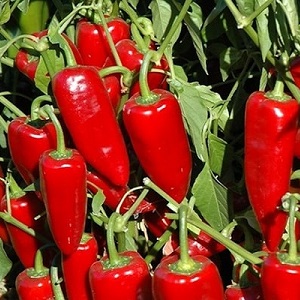 The soil is calcined in an oven at a temperature not lower than 100 ° C.
The soil is calcined in an oven at a temperature not lower than 100 ° C.
Another option is to water the soil in the boxes with a dark pink solution of potassium permanganate.
Some gardeners sow seeds in a common box. We do not recommend this method, as peppers do not like picking.
It is easier to grow healthy seedlings if sow seeds directly into individual containers. It is not necessary to buy special containers. Disposable cups, cut bottles, and juice boxes will do. Drainage holes are made at the bottom of the seedling pots.
The most convenient peat pots and tablets... In this case, the seedlings will not have to be removed from the containers even when picking to a permanent place.
Growing seedlings
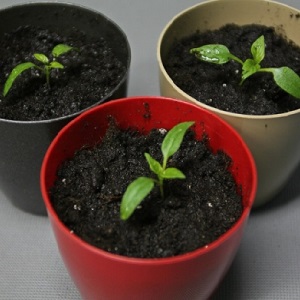 Pepper in our country is grown only in seedlings.... The seeds are sown in early May.
Pepper in our country is grown only in seedlings.... The seeds are sown in early May.
It is more convenient to grow peppers in a heated greenhousewhere it is easy to provide plants with optimal conditions. Many gardeners grow seedlings on a windowsill. In this case, it is important to provide the seedlings with sufficient illumination and optimal temperature. Otherwise, the seedlings will stretch ahead of time, and the pepper will not take root well after transplanting to a permanent place.
Peppers are planted in a permanent place after 80 days. after seed germination. By this time, at least 4 true leaves should appear on each plant.
Planting pepper
The soil is poured into boxes or individual containers... She is allowed to stand indoors for several days to warm up. The soil is watered abundantly with warm water.
Seeds are sown in boxes in rows. The distance between them should be 3 cm. 1 or 2 seeds are sown in each pot. In the second case, after the appearance of real leaves, the weaker plant is pinched.
In both cases, the seeds are buried 2-3 cm... They are sprinkled with soil, which is not tamped. Containers with planting material are covered with foil and placed in a warm place. It doesn't have to be light.
At the bottom of the containers for planting seedlings, drainage must be poured... Broken ceramics, fine gravel, crushed brick or expanded clay are suitable. The drainage is also disinfected by pouring a dark pink solution of potassium permanganate.
Further care
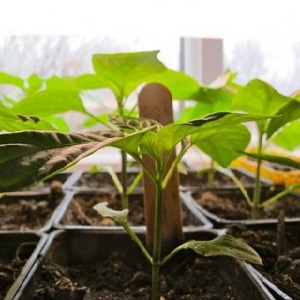 According to gardeners, peppers are more difficult to grow than tomatoes. It is important to follow the basic rules for caring for his seedlings:
According to gardeners, peppers are more difficult to grow than tomatoes. It is important to follow the basic rules for caring for his seedlings:
- After all the seeds have sprout, the film or glass is removed. The seedlings are rearranged in a well-lit place. If there is not enough light, fluorescent lamps are used.
- The room where the pepper grows must be warm... Seedling pots should not be left in a draft.
- If the seedlings are grown without fluorescent lamps, it is placed on the windowsill. At the same time, the pots are turned daily so that the light evenly falls on the plant from all directions. This will prevent the seedlings from tilting to one side.
- When the seedlings appear the first real leaves, it dives. Peppers are transplanted into individual containers with a volume of 100-150 ml. The plant, when removed from the common box, is not held by the stem, but by the leaves. It is placed in a pre-moistened soil, gently spreading the roots. When picking, the root collar is deepened no more than 5 cm.For 10 days after the procedure, the seedlings are not watered or fed.
- Water the plants as the soil dries out. Use warm, settled water.
- Top dressing is applied three times for the entire period of growing seedlings. Use vermicompost, chicken manure solution or a mixture of ammonium nitrate, superphosphate and potassium salt. The first top dressing is applied when 2 true leaves are formed on the plant, the last one 5 days before planting in a permanent place, the second one between them.
- Plant hardening will allow them to better take root in a permanent place. Pepper 2 weeks before picking begins to take out on the balcony or street. The first time hardening lasts no more than an hour, then the time is gradually increased.
Features of growing varieties
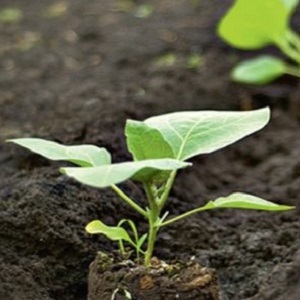 Pepper does not need shaping... Its high yield is provided precisely by branching.
Pepper does not need shaping... Its high yield is provided precisely by branching.
Once a week, the bottom of the bush is cleaned from excess foliage. Yellowed and withered greens are also removed.
After every watering the soil must be loosened. It is important to clear it of weeds in a timely manner.
Ivanhoe has low resistance to cold snaps... When grown in open ground, the first 2 weeks after disembarking to a permanent place, as well as during cold snaps, it is covered with a film overnight.
Picking to a permanent place
Pepper beds should be well lit by the sun... They are not located in areas with a close location of groundwater.
When choosing a place to grow, it is important to pay attention what plants grew there earlier. The soil on which nightshade crops have grown over the past two seasons will not work. In the beds after legumes, melons and cabbage, the variety will feel best.
Advice! Tall crops are necessarily planted between the beds with different varieties of pepper. For example, tomatoes. They will protect plants from over-pollination. It is especially dangerous to plant hot and sweet peppers close to each other.
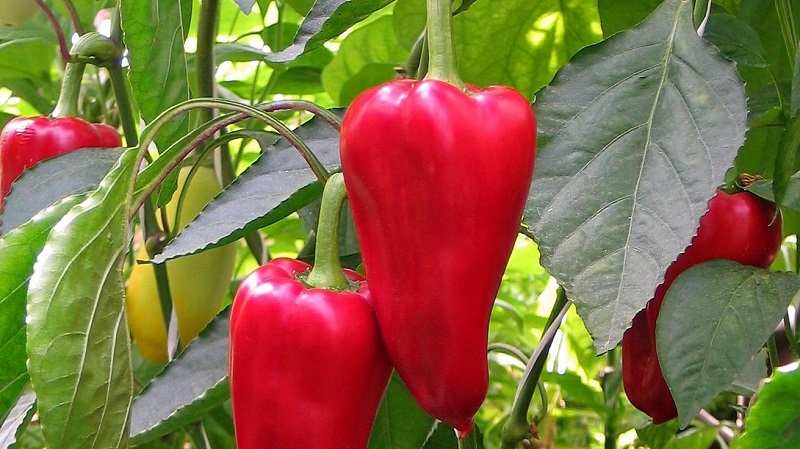
Soil preparation rules:
- In autumn the beds for the pepper are dug to a depth of 20 cm. They are cleaned of plant debris. The grass that has been collected from the beds does not have to be thrown away. It is much more useful to grind it, treat it with a potassium permanganate solution and bury it in the same area. This will make the soil more fertile. The soil is also mixed with rotted manure in the amount of 6 kg per 1 sq. m.
- In the spring the beds are dug up or leveled with a rake, watered with a strong solution of copper sulfate.
- Pepper does not like acidic soils... To make the soil slightly acidic, it is mixed with dry lime or ash.
- If the soil is heavy, sand must be added to the top layer. Otherwise, the pepper will die.
It is better to dig holes in a checkerboard pattern.... This will save more space. For planting this variety, a 50x40 scheme is used.
If the seedlings were grown in a peat container, then they do not remove it, but destroy it a little. Peppers will have to be removed from plastic pots. It is planted in holes, gently straightening the roots. The root collar is not buried.The deepening is covered with soil, which is compacted. The pepper is watered using 1 liter of water for each plant.
Before planting pepper, it is useful to pour fertilizer into the holes.... For example, long acting pellets, ash or small raw fish.
Important! In the open field, the first 2 weeks after transplantation, the pepper is covered with a film overnight.
Care Tips
Pepper is one of the most whimsical nightshade crops to care for... You need to constantly monitor him. Inexperienced gardeners are often faced with plant death or lack of fruit.
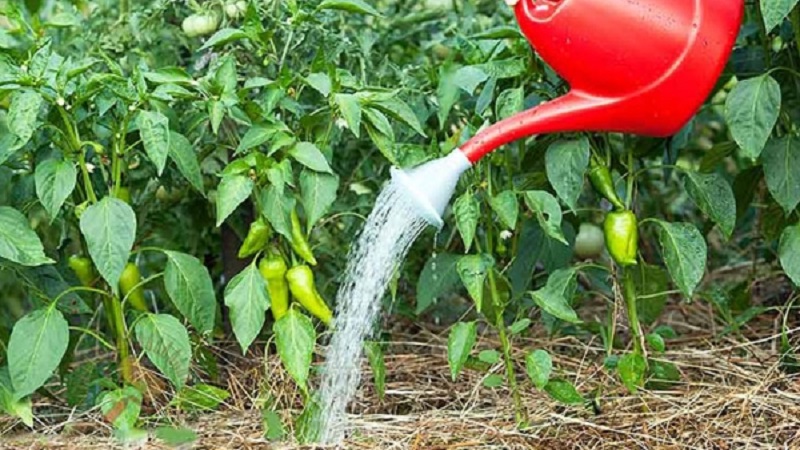
To prevent this from happening it is important to follow the basic rules:
- The beds with pepper must be mulched rotted straw, sawdust, humus, peat. This layer will protect the roots from adverse factors.
- Pepper is watered infrequently, but abundantly... Before flowering, water is poured both on the ground and on the bushes (sprayed). When flowers appear, the liquid is poured only at the root.
- To help the pepper pollinate, you need to attract pollinating insects. To do this, it is enough to spray the plants with sweet water.
- To speed up the formation of ovaries, make foliar dressing. The most popular option is to spray the bushes with a boric acid solution.
- Feed the plant three times a season. Complex mineral fertilizers with potassium and phosphorus, diluted 1:10 chicken droppings, silage (infusion of fermented herbs), infusion of food residues (fruit peel, bread, egg shells) or ash are used.
- If the stems appear roots or tubercles, it is recommended to spud them. It is important to do this not with dry, but with damp ground.
Typical diseases and pests
To reduce the chance of pepper infestationfollow the rules of prevention:
- processing of garden tools, containers and soil;
- compliance with watering rules;
- regular loosening of the beds;
- weed removal;
- compliance with the rules of crop rotation.
To protect against insects use special drugs ("Barrier") or home remedies:
- Wormwood decoction... Wormwood is finely chopped, ¼ buckets are filled with grass. The rest of the volume is poured with boiling water. When the liquid has cooled, it is filtered and used for spraying. Other bitter plants will do as well.
- Soap solution... A piece of laundry soap is rubbed and dissolved in a bucket of water. If desired, add 1 chopped onion to it.
- Serum... Whey (or other fermented milk products) is diluted with water in a ratio of 1: 5.
- Ash or tobacco... Powder is sprinkled on leaves and beds.
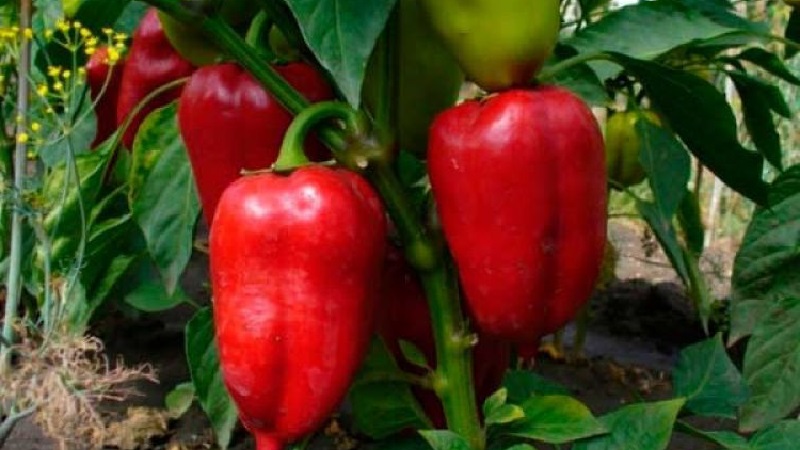
Advantages and disadvantages of the variety
Benefits of Ivanhoe:
- high productivity;
- disease resistance;
- thick fruit pulp;
- great taste of the fruit;
- no need for garter and pinching.
The disadvantages include susceptibility to cold snaps.
Read also:
Reviews
Reviews of gardeners about Ivanhoe speak of its high yield and excellent taste... Some gardeners complain about its instability to lower temperatures.
Andrey, Nikopol: “I planted Ivanhoe at the dacha right in the open ground. I arrived at the weekend and saw that half of the plants had withered due to a slight cold snap with rain. It was possible to save the plantings with the help of hilling, mulching and the introduction of a growth stimulator. The plant did not hurt. The harvest was good. I liked the taste of the fruit. In my opinion, more hardy varieties are more suitable for giving ".
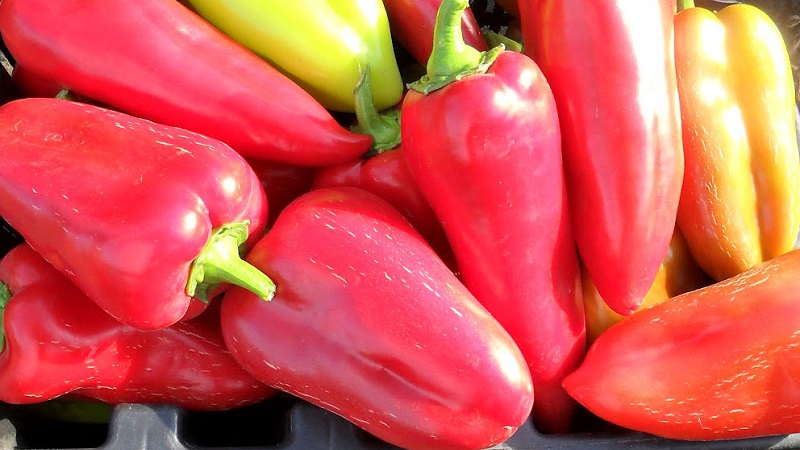
Vasilisa, Klin: “I grow Ivanhoe in a film greenhouse for sale. I apply fertilizers every 2 weeks. I alternate a mixture of superphosphate, ammonium nitrate and potassium with silage. The harvest is good, there is no need to pinch the plant. Therefore, it is easy to care for him. The bell pepper fruits are as beautiful as in the photo ".
Conclusion
Ivanhoe is a pepper with thick flesh, excellent taste and high yield. It is grown both for themselves and for sale.
Since the plant is not tall, it is not necessary to pinch and tie it up, which simplifies its care. Not afraid of peppers and diseases. The only drawback of this variety is that it does not tolerate cold snaps. Therefore, without a greenhouse, it will be possible to grow it only in regions with a southern climate.